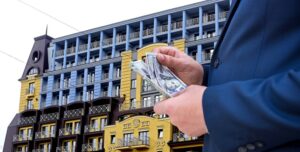
The Azerbaijani service company SOCAR AQS is considering the possibility of investing in Ukrainian subsoil, Head of the State Service for Geology and Subsoil Roman Opimakh said following a working meeting in Kyiv on Monday.
“Representatives of SOCAR AQS are interested in investing in Ukrainian subsoil because of the presence of significant potential of both hydrocarbon deposits and raw materials for the production of batteries for electric cars and electronics in our country,” Opimakh wrote on his Facebook page
According to him, the parties agreed to continue the dialogue with the aim of introducing and implementing joint business projects.
Opimakh also invited Azerbaijani partners to pay attention to the Investment Atlas of a Subsoil User, created by the State Service for Geology and Subsoil, containing vacant subsoil areas with deposits of strategic and critical minerals, as well as a data-room of secondary geological information filled with descriptive information about subsoil use objects, land plots within the contours of deposits, and also geological reports.
According to Interfax-Azerbaijan, SOCAR AQS was established in 2007 by the State Oil Company of Azerbaijan (SOCAR), Nobel Oil Services and Abşeron Qazma Şirkəti as a joint venture providing comprehensive drilling and well management services. Nobel Oil Services is the main shareholder of SOCAR AQS.
The main activity of SOCAR AQS is the provision of services and work on the design and planning of wells, drilling oil and gas wells, drilling directional wells, drilling horizontal wells, well completion, workover, sidetracking and drilling of branched wells.
National bank of Ukraine’s official rates as of 27/07/21

Source: National Bank of Ukraine
TOP 20 COUNTRIES OF UKRAINE’S FOREIGN TRADE PARTNERS JAN- APRIL 2021 (THOUSAND USD)


The European Union and the United Nations Development Programme (UNDP) in Ukraine, together with national partners, officially opened two renovated medical call centers in Kramatorsk, Donetsk region, and Severodonetsk, Luhansk region.
The equipment for the call centre, worth around EUR 17,000 (about UAH 540.000), was purchased with the financial support of the European Union under the UN Recovery and Peacebuilding Programme, the message reads.
The centers are based at Kramatorsk Primary Healthcare Centre No. 1 and Severodonetsk City Multidisciplinary Hospital. They will serve about 180,000 residents of Donetsk and Luhansk regions.
Up to six coordinators work in the call centers and use a specially designed call system, which helps them call back those who could not reach the centre immediately.
“The European Union continues to support the effective functioning of the healthcare system in eastern Ukraine, ensuring that needs of all local residents are addressed. Together with our partners from the UN Recovery and Peacebuilding Programme and the European Investment Bank, we’ve been piloting new approaches to health service delivery, which is crucial in the times of the COVID-19 pandemic, and renovating medical facilities in Donetsk and Luhansk regions,” Martin Schroeder, acting Head of Cooperation at the EU Delegation to Ukraine, said.

Bills on the reform of architectural and construction control should be developed with the direct participation of the architectural professional community.
This opinion was expressed by President of the National Union of Architects of Ukraine Oleksandr Chyzhevsky during a press conference devoted to how bill No. 5655 can destroy the architecture of Ukraine and architects as a profession held at Interfax-Ukraine.
“We highly and positively assess the efforts of legislators to eradicate corruption in the construction industry by introducing elements of the Unified Electronic System into practice. This should become a part of the overall process of digitalization of the country, the introduction of ubiquitous e-government. However, the professional community is protesting against the provisions of bill No. 5655, which curtail the powers of the architect and unbalance the industry as a whole,” Chyzhevsky said.
According to Deputy Chair of the Architectural Chamber of the National Union of Architects Anna Kyrii, today none of the numerous amendments that were transferred to the text of bill No. 5655 have been taken into account.
“In its current version, bill No. 5655 unprecedentedly deprives architects of the rights and opportunities to influence and control their project,” Kyrii said.
Kyrii called “the destruction of authorship as such” the most painful blow.
“For some reason, the creators of the bill pay attention to only one point, which directly determines that authorship is deprived if the project is carried out using budgetary funds. Yes, this point is the most terrible, because the architect is deprived of copyright property rights to the project even before that moment he began to design. However, this is not the only moment – dozens of points of the bill, one way or another, deprive or squeeze the rights of the architect, or discredit the architect in front of the rest of the project,” Kyrii said.
At the same time, the expert said that the practice of attracting famous architects to the implementation of projects significant for society, which are financed from budgetary or donor funds, is popular all over the world. And this increases the credibility of both customers and architects.
According to Chair of the expert commission of the Architectural Chamber of the National Union of Architects Olha Podushkina, the property rights of architects are protected by the law of Ukraine on copyright and related rights (section II, Article 15).
“And although the majority thinks that an architect’s copyright is about ownership of an idea and concept, in fact, an architect’s copyright is primarily about his responsibility for the quality and safety of the project,” Podushkina said.
The expert said that for an architect, a project is not only a set of reinforced concrete structures, glass and engineering systems, but a harmonized spatial structure of the human life environment, which should be created taking into account aesthetic principles, reliability, environmental friendliness, and functional comfort. “Only an architect can organize the process of implementing his project and help the customer to obtain a high-quality product. Only an architect can control the implementation of the designed solutions that shall meet all standards. Only in this case the building will serve the projected period, it will be safe and comfortable, aesthetically pleasing and environmentally friendly,” Podushkina said.
According to Kyrii, the current version of bill No. 5655 creates a corruption risk for projects implemented using budgetary funds: if, after the approval of the project and its estimate, the customer, seeking to save money, makes a choice in favor of materials and solutions of lower quality.
“If the architect does not have leverage to influence this choice, and this is also a security issue, buildings will simply come down with cheaper materials. On the other hand, if accounts are settled according to the previously approved estimate, and cheap materials are used, who will check it? and who will be responsible for this?” Kyrii said.
Chyzhevsky said that the rights of architects should be harmoniously combined with responsibilities.
“Duties can be fully fulfilled only when there are full rights, in particular, property copyright,” Chyzhevsky said.
The experts called the creation of the Urban Development Chamber as another controversial point of the bill.
According to Kyrii, this initiative leads to the strengthening of centralized power instead of expanding the rights of horizontal structures, i.e., in fact, it leads to the leveling of the very practice of self-regulation.
According to her, bill No. 5655 will unbalance the entire system.
“An architect is deprived of his rights and at the same time he is entrusted with even greater responsibility. We are becoming even more dependent on those who are still in charge of the market. The main resource is concentrated in the developers, those who distribute funds. In most cases, they are the initiators of violations of state building codes, saving resources, replacing quality materials with cheaper ones,” the expert said.
She drew attention to the fact that at the same time, it is for developers that the current version of the bill expands the rights.
“The Urban Development Chamber will supervise the responsible executors of the works, and the developers will receive both property copyrights and urban planning control, which they can order from legal entities,” Kyrii said.
According to Chyzhevsky, the organization of separate bodies with the broadest possible powers is extremely dangerous.
“This creates many additional levers of influence on responsible executors, which is demonstrated by the experience of SACI,” Chyzhevsky said.
The expert said that self-regulation is a sign of our times.
“On the one hand, this is a component of the formation of civil society, which ensures stable democracy, which is so important for our country. On the other hand, the implementation of the powers delegated by the state, the process of certification of a creative employee by a creative employee, which is implemented by the National Union of Architects, meets not only the recommendations of the World Organization of Architects, but also the obligations of the state of Ukraine to the WTO and the EU,” Chyzhevsky said.
ARCHITECTURAL CONTROL, DEVELOPED, PROFESSIONAL COMMUNITY, REFORM